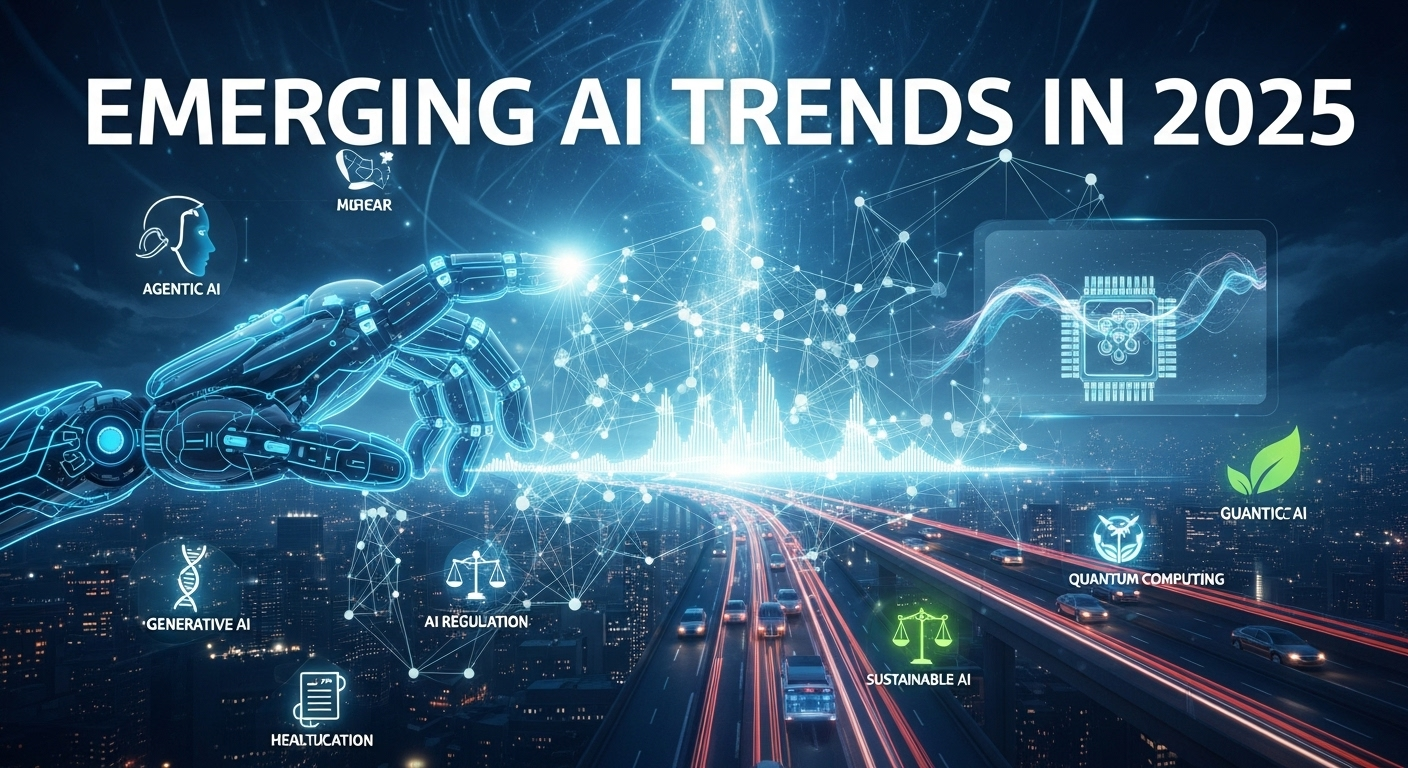Emerging AI Trends in 2025: What’s Transforming the Tech World Now
The landscape of artificial intelligence is evolving faster than ever. From autonomous agents to sustainable AI infrastructure, these ten key AI trends highlight where innovation is actively shaping industries today in 2025.
10. Agentic AI: From Tools to Autonomous Agents
Agentic AI refers to self-operating systems capable of interpreting goals, executing tasks, and adapting to new contexts with minimal human input. It’s becoming enterprise-ready—automating workflows in areas like travel planning, code generation, and customer engagement. The Economic TimesBarron’sBusiness InsiderServiceNowLatest AI
Adoption is accelerating quickly: companies report a surge to 82% using coding agents in corporate engineering by mid‑2025, though full autonomous deployment is still early-stage. Business Insider
Enterprise platforms such as AWS AgentCore and Microsoft’s Azure-based agents now offer scalable frameworks for task automation, signaling that agentic AI is entering widespread commercial adoption.
Forbes+2TechRadar+2Barron’s+2
9. Generative AI Expansion: Beyond Text to Seamless Creativity
Generative AI continues advancing beyond text and static images. OpenAI’s Sora now generates dynamic video clips up to 60 seconds from textual prompts, blending motion, lighting, and context with high fidelity. latimes.com+10help.openai.com+10o-mega.ai+10
OpenAI is reportedly developing Sora 2 to compete with Google’s Veo 3. bleepingcomputer.com
Meanwhile, major players like Netflix and Disney are exploring tools such as Runway AI for video production, highlighting real-world media uptake of generative video models. outlookbusiness.com+1latimes.com+1
8. AI in Healthcare: Early Detection and Personalized Care
AI-powered platforms like DERM (Deep Ensemble for Recognition of Malignancy) have been conditionally approved by NICE for NHS use. Triaging suspicious skin lesions with rapid results and high reliability—reported sensitivity at 100% and NPV up to 99.8%. standard.co.uk+11nice.org.uk+11digitalhealth.net+11
In addition to early cancer detection, AI is reshaping diagnosis, tailoring treatments based on genetic and lifestyle data, and optimizing healthcare operations with predictive monitoring and workflow automation.
7. Hyper-Personalization: AI-Driven Customer Experiences
AI hyperpersonalization is transforming marketing and customer engagement. By analyzing user behavior and preferences, businesses deliver tailored services and content in real time. This enhances user satisfaction, builds loyalty, and strengthens brand positioning in a crowded digital landscape.
6. AI Regulation and Ethics: Governance Finally Catches Up
The EU AI Act (Regulation (EU) 2024/1689), officially in force since August 1, 2024, has introduced phased legal and ethical frameworks. High-risk AI practices were banned starting February 2, 2025, and fines and broader provisions come into force in August 2025.
artificialintelligenceact.eugrunecker.dematheson.comjdsupra.comeprnews.comjdsupra.com
Key obligations for general-purpose AI models and new guidelines were published this July, reinforcing transparency, risk classification, and data governance for developers and deployers. jdsupra.com
Regulators and organizations in the US and UK are also crafting frameworks that promote responsible innovation without hindering growth.
5. AI in Robotics: The Rise of Generalist Humanoid Intelligence
In March 2025, NVIDIA introduced the Isaac GR00T N1—the first open-source foundation model for humanoid robots, trained on multimodal data for generalized reasoning and task adaptation across environments. blogs.nvidia.com+11nvidianews.nvidia.com+11actuia.com+11
Follow‑ups like N1.5 and “GR00T‑Dreams” further accelerate robot learning via synthetic simulation and real-world fine‑tuning, supporting manufacturers, logistics, and beyond. futurumgroup.com
4. AI-Powered Voice Assistants: More Natural, Context-Aware Interfaces
Voice assistants are evolving into conversational AI companions capable of context-aware dialogue. Amazon, Google, and Apple are integrating generative AI to enable more intuitive, adaptive voice interactions—improving utilities in customer service, home automation, and beyond.
3. AI Meets Quantum Computing: Boosting Capabilities
AI increasingly supports quantum computing by optimizing algorithms, error correction, and system stability. Collaboration among companies like NVIDIA, Google, and IBM is laying the foundation for quantum‑AI hybrid systems that target real-world applications such as drug discovery, financial modeling, and climate simulations.
2. Sustainable AI: Ethical Innovation for a Greener Future
Large AI models carry significant energy costs, prompting a shift toward more sustainable infrastructure. Initiatives include NVIDIA and Schneider Electric partnering on digital twins of data centers, and platforms like Capalo AI predicting renewable energy production to improve grid efficiency. Industry coalitions like Open Power AI are designating AI models for energy sector optimization—balancing innovation with ecological responsibility.
1. AI in Autonomous Transportation: Toward Widespread Mobility
AI-driven sensing, navigation, and decision-making systems are steadily advancing autonomous vehicles from lab prototypes to real‑world deployment. Progress continues, especially in sensor fusion and safety validation layers. Although regulatory and ethical considerations remain key hurdles, increased collaboration between governments and tech firms is accelerating public acceptance and readiness for broader adoption.
Concluding Thoughts:
These ten trends showcase how AI is evolving from reactive tools into powerful, autonomous collaborators—reshaping workflows,industries, and societal infrastructure. From regulatory breakthroughs in Europe to sustainable AI practices and agentic computing, the next phase of AI innovation is underway.
For businesses and developers, the emphasis should be on strategic adoption, robust governance, and human-led oversight. Start with clearly defined, manageable use cases; pilot responsibly; and expand incrementally through ethical frameworks.
